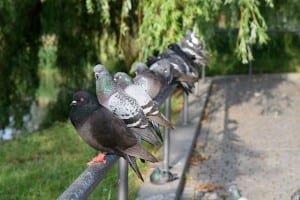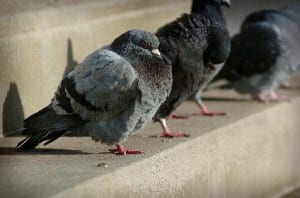
by Pigeon Patrol | Sep 5, 2014 | Pigeon Patrol's Services, Pigeon Spikes, Pigeons in the News, UltraSonic Bird Control
 SEOUL, Sept. 5 (Korea Bizwire) – Piano wire, made for use in piano strings, has found a new, unexpected use in chasing pigeons away so that buildings and structures could avoid premature corrosion as well as bad odor and noise. The Seoul metropolitan city government said on September 4 that it has come up with a novel solution to keep birds away using piano wire by experimentally installing the line on Seongsan No. 1 Bridge and the Seoul Station Overpass.
SEOUL, Sept. 5 (Korea Bizwire) – Piano wire, made for use in piano strings, has found a new, unexpected use in chasing pigeons away so that buildings and structures could avoid premature corrosion as well as bad odor and noise. The Seoul metropolitan city government said on September 4 that it has come up with a novel solution to keep birds away using piano wire by experimentally installing the line on Seongsan No. 1 Bridge and the Seoul Station Overpass.
The solution is based on a simple idea that the birds wouldn’t be able to land on the extremely thin line and would fly away after trying many times. Until now, most bridges and elevated roads have been infested with pigeons, causing bad smell, often unbearable noise, and urban squalor. In some problem spots, the city government tried to install bird blocking nets but found it ineffective as most pigeon habitats were narrow holes or small cracks.
The idea of using piano wire came when a bike rider passing underneath Seongsan No. 1 Bridge petitioned the city government to do something about the pigeon problem and a city officer named Lee Jong-wook at the West Seoul Road Maintenance Corp. under the city government invented the idea after weeks of experiment. He applied for a patent for the idea with the Korea Intellectual Property Office.
Pigeon droppings may cause corrosion of steel parts in the structure as they contain ammonia and acid when they are mixed with rainwater. The droppings are major nuisance to pedestrians walking under bridges and overpasses. The piano wire-based bird chasing device is more cost effective than any other solutions such as the spike needle, bird blocking net, chemical-based bird repellent and ultrasonic bird repeller, which are expensive and often limited in applicable range.
Its installation is also simple, with no need to replace often through the tightness adjustment lever and elastic spring that tightens the line even when the temperature is high. As the wire is made from tempered high-carbon steel, it is durable and can maintain elasticity for a long time.
Lee of the West Seoul Road Maintenance Corp. said, “I thought hard and long about how to address the problem and came up with the idea of piano wire. When I developed the idea, it was winter time, which made it hard to apply any other easily available solutions. I am glad that my simple idea could relieve the problem and make our citizens happy.”
About Pigeon Patrol:
Pigeon Patrol Products & Services is the leading manufacturer and distributor of bird deterrent (control) products in Canada. Pigeon Patrol products have solved pest bird problems in industrial, commercial, and residential settings since 2000, by using safe and humane bird deterrents with only bird and animal friendly solutions. At Pigeon Patrol, we manufacture and offer a variety of bird deterrents, ranging from Ultra-flex Bird Spikes with UV protection, Bird Netting, 4-S Gel and the best Ultrasonic and audible sound devices on the market today.
Voted Best Canadian wholesaler for Bird Deterrent products four years in a row.
Contact Info: 1- 877– 4– NO-BIRD (www.pigeonpatrol.ca)

by Pigeon Patrol | Sep 4, 2014 | Bird Deterrent Products, Bird Netting, Pigeon Patrol's Services, Pigeon Spikes, Pigeons in the News
Pigeons and humans have co-existed for thousands of years. But when they become a nuisance, who is to be blamed?
 Pigeons, one of the most resourceful species on the planet, are traditionally, symbols of love, peace, family and faithfulness. Their inflated throaty coos are a common sound in virtually every part of the globe with the exception of the Sahara Desert and the Polar ice caps. It is ironic that the species is currently being referred to as “the most serious bird pest associated with human habitations”.
Pigeons, one of the most resourceful species on the planet, are traditionally, symbols of love, peace, family and faithfulness. Their inflated throaty coos are a common sound in virtually every part of the globe with the exception of the Sahara Desert and the Polar ice caps. It is ironic that the species is currently being referred to as “the most serious bird pest associated with human habitations”.
Flock together
Pigeons have lived alongside humans and been used for food, sport and as messengers. Considered one of the most intelligent species on the planet, pigeons can perform tasks previously thought to be the sole preserve of humans and primates.
Descended from wild rock doves that thrive in a cliff environment, feral pigeons form large flocks that roost on building and ledges and under bridges. They can often be found in loft spaces and empty buildings — anywhere that offers a small amount of shelter.
Naturalist Dr. T. Murugavel says, “Feral pigeons thrive in urban areas in particular because there is usually a good food source and the absence of predators. The result is that they can become ‘pests’ in built-up areas. Unless food is strictly controlled, pigeons will rapidly breed out of control, resulting in overpopulation in areas of human habitation. Researchers have proved that pigeons do not usually like any change in their nesting area. Even a decoy or an image of a raptor when placed in the nesting or roosting area of pigeons discourages them from nesting. Whatever you do, ensure that it is humane and eco-friendly.”
Research conducted around the world to find a humane way to control, includes methods like ‘birth control’ pellets to controlling the number of eggs allowed to hatch, spikes to deter landing and thorny cacti on a sunny windowsill! But aren’t ‘pigeon problems’ really ‘people problems’? Can we coexist better with a bird that has survived in close association with man for over 10,000 years?
A recent report in The Independent spoke of how people found feeding pigeons in the Austrian city of Vienna were to be fined €36 in an attempt to keep the city clean. Pigeon experts from the animal welfare ombudsman said that it was rubbish in the city that caused problems beyond the pigeon population. Obviously, unclean neighbourhoods in any part of the world are the reason for many health and environmental issues, but looks like it is the issue that is being most conveniently pigeonholed!
Shoo!
The National Audubon Society Birds site, which gives tips on “how to shoo them away”, says that many safe and effective commercial products are also available including plastic or metal bird spikes. If pigeons are roosting on a utility wire or other area where they can’t be easily blocked, a weatherproof bird sound device that plays bird alarm or distress calls may chase them away.
Downside
Pigeon droppings are acidic and can cause damage to buildings and machinery. Nesting material, droppings and feathers can block drains and air vents. Startled flocks that take flight suddenly may cause hazards to motorists and pedestrians. While large numbers of pigeons can drive smaller birds away from feeding areas, they can also spread disease to other birds.

by Pigeon Patrol | Sep 4, 2014 | Bird Deterrent Products, Bird Netting, Pigeon Patrol's Services, Pigeon Spikes, Pigeons in the News
 Rufus the Hawk reports for duty weighing 625 grams.
Rufus the Hawk reports for duty weighing 625 grams.
Ten grams more and he’s too sedentary. Any lighter, and he ceases being the non-lethal deterrent Wimbledon contracts him to be and roams farther afield for mouse, snake or hare.
But if Rufus arrives at his optimum weight, he need only soar over centre court a few times to earn his hand-fed reward of raw chicken bits.
The mere sight of his one metre wingspan is enough to shoo away the pigeons that might otherwise land on the court during a critical point, deposit droppings in the Royal Box or roost in the eaves to feast on grass-seed all winter, as if the sod were a buffet table.
A 6-year-old Harris Hawk with prodigious self-esteem, Rufus is just one of several hundred actors in the meticulously choreographed dance that unfolds between dawn and 10.30am daily in London throughout the Wimbledon fortnight.
From strawberry-hullers to bomb-sniffing English Springer Spaniels, every man and beast has a task before the All England Club’s wrought-iron gates open to the tennis-mad public. And every task – whether mowing, measuring, marking, pruning, watering, soaring, sniffing, sweeping, scrubbing or polishing – has its appointed time for completion.
No detail is overlooked. Everything must be just so at the most esteemed of the four Grand Slams. A ticket to Wimbledon, after all, constitutes an invitation to a private club that opens to royals and commoners alike for two weeks each year to watch the world’s best players in the most pristine setting in sports.
“It’s all about the details,” says Lucy Tomlinson, 21, a member of Wimbledon’s daytime housekeeping staff, which from 7.30am onward restocks the loos with soap and hand towels, polishes the banisters, scrubs scuff marks from the entryways and wipes away beads of water left by the power-washing of ticket-holders’ seats.
“We make sure everything is absolute perfection!”
Neil Stubley, the head groundsman, starts his day with a 5.30am check of the forecast. Based on that, he directs his staff when to deflate the translucent covers on the 41 grass courts so they can be rolled up and stowed and the sod watered if the daily measurements of its hardness indicate there’s a need.
All of Wimbledon’s courts are oriented in a north-south direction. A specific groundskeeper is assigned to each court for the tournament’s duration. And each mows the rye grass to precisely 8 millimetres each morning, in exactly the same pattern of alternating stripes.
Every cutting is captured by the mower; even a stray snippet of grass could cause a player to slip.
“If Roger or Andy or Rafa goes out onto any of the practice courts in the morning and then comes out to any of the match courts, they should play exactly the same because we have controlled the moisture, the grass species and the cutting,” explains Stubley, who supervises a staff of 32 groundskeepers and gardeners.
Then come pairs of groundskeepers who mark the lines with titanium dioxide and set up the nets.
By that point, roughly 9am, David Spearing has started work at the golf course across Church Road that doubles as a camping ground for the thousands of fans in the queue for tickets.
Wimbledon’s honorary chief steward, Spearing has the privilege of informing the campers over a loudspeakers at 7.30am the number of tickets available for public sale that day and handing out the wristbands that guarantee entry to centre court, court 1 or the grounds in general.
It is but one of his duties. The other is sitting in the players’ guest box on centre court. Wimbledon is the lone major that seats the relatives, coaches and friends of both players in the same box. And Spearing, expert in protocol and discretion, is on hand to greet, seat, and on the rarest occasion, mediate.
“It’s basically an honour to have the job, rather than any particular ability,” says Spearing, who sits in the corner of the 39-seat box, with the top seed’s 19 guests to his right and the lower seed’s 19 guests to his left.
“Being pleasant is easy.”
Based on wags, few enjoy their early morning rounds more than dogs tasked with sniffing potential explosives. A mix of spaniels and retrievers, they scamper up and down the walkways, peer under benches and poke into trash bins positively quivering with excitement over the prospect of finding something that warrants a prize. At Wimbledon, naturally, that prize is a fuzzy yellow tennis ball.
Dogs, however, are one of the few sights that unsettle Rufus. So handler Imogen Davis, whose parents and five siblings breed and train raptors for a living, does her best to steer the hawk clear of Wimbledon’s canines. It’s not always easy, given that Rufus’s vision is 10 times better than her own.
“If Rufus was at one end of a football pitch, and a newspaper was at the other end, Rufus could read the headline!” Davis says by way of illustration.
“If he could read.”
One could get the impression Rufus can indeed read from his Twitter account, @RufusTheHawk, which reveals a raptor of cracking wit and considerable ego. Among his recent tweets: “Chasing pigeons is an art form, like poetry or twerking. And I, Rufus, am an artist.”
And, “The reason Sharapova is so loud when she serves is because she wants to scare away pigeons to be more like me.”
Apart from the sight of dogs, nothing rattles Rufus. Not the sound of Wimbledon’s lawn mowers. Not the sound of leaf blowers. Not even the fire alarm that gets a full-song test each morning at 9.35am.
It’s followed at 9.45am by a call over the public-address system for all staff and contractors to remove all vehicles and carts from the grounds in preparation for the opening of the gates, 45 minutes away.
And the pace of activity picks up.
Gardeners deadhead petunias and pluck yellowed leaves from ferns and hydrangeas at Centre Court’s South Entrance, where guests of the Royal Box enter.
The 250 ball boys and girls start arriving at Gate 13. They form a single-file line and march up the steps of St. Mary’s Walk without uttering a word, the only sound the pad of 500 sneakers on the pavement.
Aged 14 to 18, the schoolchildren have trained for this duty since late January, schooled by gym teacher Sarah Goldson in how to properly roll tennis balls between points, how to raise their right hand before feeding the ball to the server and, above all, how to stay still during play.
“They can move their eyes, and they can wriggle their toes,” Goldson says.
“But that’s about it.”
They also must wear their uniform correctly. Shoelaces must be tied in double knots. Shirts must be tucked in; trousers worn at the waist, not sagging in any manner. Water bottles must be tucked on the right side of their backpacks. And for girls, long hair must be tied back.
“Make-up, chewing gum is a big no-no.” Goldson adds.
“Jewellery, definitely not!”
As the ticket holders mass at the gates, the strawberry-sorters’ hands are flying in a chilled catering room tucked behind the grounds’ largest food court. Wearing green fleeces for warmth, a staff of six sits around a table and inspects and hulls the berries. They’re picked at 5am daily at a farm an hour’s drive away and delivered to the grounds by refrigerated trucks.
No scales are needed for the portioning out; it’s 10 strawberries per little plastic bowl. And roughly 8600 bowls, or “punnets,” are consumed daily.
Outside the sun inches higher in sky. The clock shows 10.25am, the next cue for Wimbledon’s public-address announcer.
“Attention ladies and gentlemen, we will shortly be opening the gates,” he advises.
“In the interest of your own and others’ safety, please do not run.”
In five minutes’ time, everything is in its place. The dogs have exited with their minders. The ball boys and girls have assumed their posts. Two towels have been placed on each player’s chair on every court. The air smells of petunias in full bloom.
And Rufus, having secured his realm for another day, has slipped on the custom leather hood that signals naptime and a job well done to Wimbledon’s brave hawk.
About Pigeon Patrol:
Pigeon Patrol Products & Services is the leading manufacturer and distributor of bird deterrent (control) products in Canada. Pigeon Patrol products have solved pest bird problems in industrial, commercial, and residential settings since 2000, by using safe and humane bird deterrents with only bird and animal friendly solutions. At Pigeon Patrol, we manufacture and offer a variety of bird deterrents, ranging from Ultra-flex Bird Spikes with UV protection, Bird Netting, 4-S Gel and the best Ultrasonic and audible sound devices on the market today.
Voted Best Canadian wholesaler for Bird Deterrent products four years in a row.
Contact Info: 1- 877– 4– NO-BIRD (www.pigeonpatrol.ca)

by Pigeon Patrol | Aug 7, 2014 | Bird Deterrent Products, Pigeon Spikes, Pigeons in the News, UltraSonic Bird Control
 BATHURST Regional Council has not ruled out resorting to using birds of prey in an effort to control the pigeon problem in the central business district.
BATHURST Regional Council has not ruled out resorting to using birds of prey in an effort to control the pigeon problem in the central business district.
Council has had discussions with Dubbo City Council regarding its success in using falcons to encourage pest species to leave the main shopping precinct.
A report to tomorrow night’s ordinary monthly meeting updates council on how Bathurst’s pest bird management strategy has fared since it was adopted in 2012.
One of the recommendations of the plan was to introduce a co-ordinated pigeon control program involving council facilities and businesses in the CBD.
Council conducted a successful program during 2012-2013, when 1089 pigeons were removed from council and private properties.
According to the report, council’s environmental staff have discussed with staff from Dubbo City Council that city’s recent trial using native birds of prey.
“Dubbo has a problem with starlings nesting in trees in the main street, causing $12,000 of annual clean-up costs,” the report states.
“They engaged a falconry company to conduct a trial using four different predator bird species that would fly in the area with the intention of moving the starlings on.
The program was moderately successful for two of the birds used though more trials are needed to determine if the program would work on an ongoing basis.
“This may or may not work in the Bathurst context in relation to pigeons as they are impacting across a broader area and moving the birds from one place to another may not reduce the issue.
“Council staff will continue to receive updates regarding the Dubbo trial to determine if a similar program could be conducted locally.”
The report also notes that pigeon control efforts have also continued in 2013-14 with a targeted trapping program in Machattie Park.
However, this was largely unsuccessful as pigeons are attracted to the high volumes of artificial food supply at the duck ponds and therefore could not be enticed to the trapping area.
“Since then, council has recently commenced a trapping program at the Post Office building, the TAFE complex and at one private building in the CBD,” the report states. “These three sites have the highest populations and therefore have been targeted first before the program moves onto activities at other CBD properties.”
In other pest bird initiatives, council hosted a community Indian Myna workshop, attended by local and regional residents as well as staff from Bathurst and Orange councils.
Presentations were given by the Clarence Valley Indian Myna group and the Pest Cooperative Research Centre’s Mynascan project coordinator.
Thirty Indian myna traps were distributed on the day (for a small cost) so that interested community members could remove these pest birds from their area.
Council staff will continue to implement the Pest Bird Management Plan as required and as funding and resources permit.
About Pigeon Patrol:
Pigeon Patrol Products & Services is the leading manufacturer and distributor of bird deterrent (control) products in Canada. Pigeon Patrol products have solved pest bird problems in industrial, commercial, and residential settings since 2000, by using safe and humane bird deterrents with only bird and animal friendly solutions. At Pigeon Patrol, we manufacture and offer a variety of bird deterrents, ranging from Ultra-flex Bird Spikes with UV protection, Bird Netting, 4-S Gel and the best Ultrasonic and audible sound devices on the market today.
Voted Best Canadian wholesaler for Bird Deterrent products four years in a row.
Contact Info: 1- 877– 4– NO-BIRD (www.pigeonpatrol.ca)

 SEOUL, Sept. 5 (Korea Bizwire) – Piano wire, made for use in piano strings, has found a new, unexpected use in chasing pigeons away so that buildings and structures could avoid premature corrosion as well as bad odor and noise. The Seoul metropolitan city government said on September 4 that it has come up with a novel solution to keep birds away using piano wire by experimentally installing the line on Seongsan No. 1 Bridge and the Seoul Station Overpass.
SEOUL, Sept. 5 (Korea Bizwire) – Piano wire, made for use in piano strings, has found a new, unexpected use in chasing pigeons away so that buildings and structures could avoid premature corrosion as well as bad odor and noise. The Seoul metropolitan city government said on September 4 that it has come up with a novel solution to keep birds away using piano wire by experimentally installing the line on Seongsan No. 1 Bridge and the Seoul Station Overpass.







